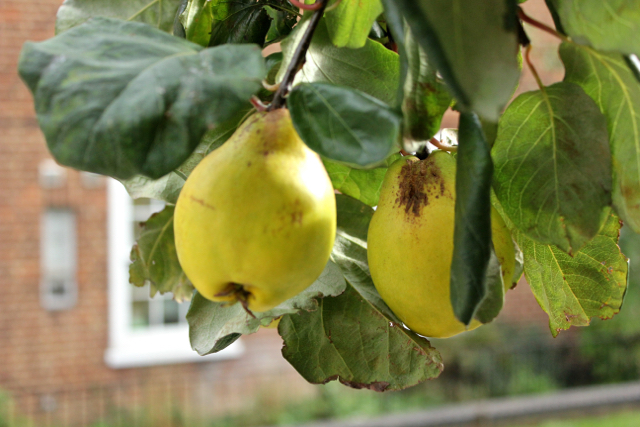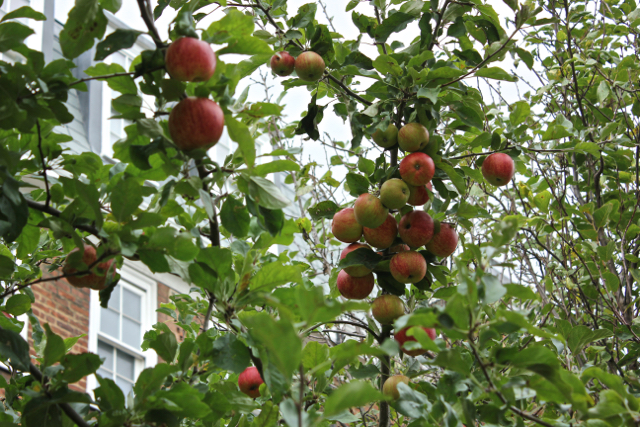Ah, autumn! A time to clear and mulch beds, think about what to grow next year, sow seeds for micro leaves, plant bulbs and get creative in the kitchen. Busy, busy. Possibly even busier than spring as autumn feels more urgent, especially with harvests to deal with and winter creeping closer.
This year I've had some good harvests but what to do with the surplus? When I thought I couldn't possibly eat another fresh courgette/tomato/bean/apple, it was time to get out the preserving books and kilner jars - waste not, want not as it's said.
I've harvested large bowls of tomatoes, achocha, beetroot, apples, quinces - but almost anything can be stored for winter use by pickling, drying, bottling, freezing or cooking.
What's the point, you may ask, with so much food available from the shops or farmer's markets? The point is that I (or you) have grown it myself. I know the soil the food's been grown in, I know that it's organic and no pesticides have been used, I know that I've harvested at the perfect time for flavours to be fully and naturally developed. And I'm also storing memories and hope. So this post is about preserving the best of what I've grown this year.
Living so close to Hampstead Heath, a bit of foraging is on the agenda, but not for sloe gin this year. As I'm not very tall the reality is that the sloes that I could easily gather three years ago are now out of reach, available only to birds. This is how it should be.
Rose hips, on the other hand, are in plentiful supply, both in the wilder parts of the Heath and (with a ladder) at the top of a large climbing rose near my own veg patch garden. But that's for next week; this week I've pickled quinces, filled jars with spiced pickled beetroot, preserved tomatoes in oil and balsamic vinegar for winter pizzas and stews, and made a small batch of quince jelly with the last of the quinces.
If the rain holds off, I'll be out foraging and next week I'll be making rosehip syrup, achocha jam, green tomato chutney and sweet chilli/apple sauce. It's also a good time to see what the farmer's market has for sale to fill a few gaps in the storecupboard; pickled beans are particularly yummy but probably out of season by now. (I don't have the need to visit the market that often.)
I'm guessing that many readers are already dab hands at preserving; for anyone new to it, I've put a book list at the end of the post.
 |
| ~ It's been a good year for Quinces in the Veg Patch ~ |
Preserving Quince
One of my neighbours remarked on how many lemons were on the tree this year. In fact, it was the quinces that drew their attention; in the past couple of weeks the skins have quickly transformed to deep golden yellow, exactly the colour of lemons.On closer inspection, I noticed that a lot of the fruit had split - no doubt as a result of recent heavy rainfall. Once fruit is damaged, the race is on to use up the good bits; fruit with brown rot needs to be disposed of quickly but not into the compost. Mine involved a fair amount of chopping (a good sharp knife is needed) as there were also mushy bits where the fruit had been pecked. I set aside an evening to get this done - time consuming but worth it.
Last year I made quince jelly, (recipe behind link), very tasty and has proved to store extremely well. This year I found an easy recipe for pickled Spiced Quinces in my National Trust book of 'Complete Jams, Preserves and Chutneys'. The finished product needs to be stored for three weeks for the flavours to infuse but already looks a pretty pink and will go well with roast pork, duck, ham, paté - and cheese! (Link to recipe, opens in new window.)
Growing note:
In the three years that my quince (variety, Champion) has produced fruit, I've waited until the fruit turns golden before harvest, usually mid to late October. Given the number of damaged fruit every year, I think I should be harvesting the fruit earlier and letting it ripen indoors. The RHS advises wrapping perfect fruit in newspaper so they remain separate and letting them ripen for six weeks. This only works for perfect unblemished fruit so I've always processed mine straight away. Next year more vigilance is needed and earlier picking.
 |
| ~ So many apples, so high up ~ |
Preserving apples
There are still plenty of Braeburn apples on the tree, lovely and ripe as you can see in the pic above, but some have been pecked at by birds and others brought to the floor by storms. The windfalls (battered, bruised, pecked but still plenty of good bits) are not wasted but brought into the kitchen to make into purée, sauce or chopped and cooked with spices for the freezer.For this I usually cook chopped and peeled apples with a sprinkle of cinnamon, a couple of star anise and a spoonful of demerara sugar. Vanilla is also good. On Instagram I saw a post where apples were cooked with cardamom which I tried and is delicious. Chopped apples freeze well and are a joy in the middle of winter when home grown food is scarce. I use mine in a crumble, over pancakes, with porridge or just with custard or cream - yum! Of course there's also apple cake, dried apple rings, apple rings fried in butter to go with an oven roasted vegetable salad. But the flavour of a well developed Braeburn is best appreciated freshly picked; bursts of hot sun this summer and last have ripened my crop beautifully.
Preserving beetroot
Growing my own has taught me to love beetroot (such a change from ten years ago) but I have to confess that my favourite beetroot to snack on are those baby beets pickled with juniper or chilli from the shops - so delicious and, for me anyway, they seem to ward off a cold. (There is some evidence that beetroot will boost the immune system but I doubt I could manage the recommended one litre of juice a day!)While beetroot is still in season, I thought I'd try pickling some. I was inspired by a book on Swedish food which provided a recipe for preparing beets to be eaten with paté, apparently very popular in Scandinavia for lunch.
The recipe seemed easy, and it was. I boiled and skinned the beets, made the brine, put all in a large jar and can now forget about them for three weeks before eating. Yum, beet heaven to look forward to! But best done on a day when the windows can be open unless you don't mind the smell of vinegar. (Recipe via this link, opens in new window)
 |
| ~ Balcony Redcurrant tomatoes ~ |
Preserving tomatoes
I had such a lot of tomatoes this year - well, let's face it, there were a lot of tomato plants even after I'd given some away! So I've had them in sauce, on ciabatta, in salads, on toast ... and still they come. The last few handfuls have been halved, then oven-dried slowly with a sprinkling of caster sugar, salt and chopped herbs; after an entire night in a low oven (100°C), they were taken out, cooled, put into sterilised jars and covered in olive oil. They'll keep like that until needed for a winter casserole, or a midwinter treat of home-grown tomatoes on toast.I hope this has been useful, join me next week for the next kitchen instalment? And if you have autumn recipes to share, please link in the comments below.
Preserving Books List:
These are the books that I've found useful over the years.
- How to Store Your Garden Produce, Piers Warren. Very comprehensive on methods and how to store your produce. I reviewed the book in this post.
- The Garden to Kitchen Expert, Dr D.G. Hessayon. Storing, recipes for cooking straightaway and hints on produce
- National Trust complete Jams, Preserves and Chutneys, Sara Paston-Williams. Gorgeous looking book, many very tempting recipes for jellies, jams, fruit butters, leathers, etc etc.
- Preserves, Pam Corbin (River Cottage Handbook No 2). Practical information and seasonal recipes from hedgerow to garden from the queen of jam making.
- The Edible Garden, Alys Fowler. Lovely book, stuffed with good advice on varieties, growing, harvesting, and using your produce. as Alys says, "How to have your garden and eat it".
- Jekka's Herb Cookbook, Jekka McVicar. History, harvesting and uses for just about every herb you can think of - and then some.
- Kew on a Plate, Raymond Blanc. Found a copy in my local library and found it hard to give back! Growing notes from Kew's kitchen gardeners, recipes from renowned chef Raymond Blanc. A few preserving recipes - I'm keen to try his green tomato chutney recipe.


0 comments:
Post a Comment
Thank you to everyone who leaves a comment, it helps to know that my scribblings are being read! If you have a question, I'll answer it here or contact me via the 'Contact Me' form at the top.
Comment moderation is on to avoid spam nonsense getting published. No offence to genuine commenters who are very welcome!